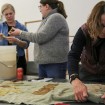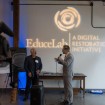John Thelin Discusses His New Book: "Going to College in the Sixties"
John Thelin, a University Research Professor in the educational policy studies and evaluation department in the UK College of Education, has published prolifically on the history of higher education and college sports. His new book, published by Johns Hopkins University Press, is “Going to College in the Sixties.” Thelin will present at a colloquium March 5 at 5 p.m. in the Hilary J. Boone Center. A reception and book signing will follow the talk. Here, Thelin answers questions about his new book.
How long have you been at UK and why did you choose this topic?
I've been at the University of Kentucky as a professor for 22 years. And, I've been studying and writing about the history of higher education for about 45 years, starting in Graduate School at the University of California Berkeley. I avoided this topic for a long time because it does involve personal history. Because I was a student and going to college in the ’60s. I decided that since most of the professors who went to college in the ’60s are retiring, that this was a good time. It's also the 50th anniversary of many of the landmark events and demonstrations. So, I felt there was time for historical perspective. My concern was that most of the characterizations of college in the ’60s were dramatically stilted toward student protest, unrest, demonstrations. And I think those are very important parts of the story. I also wanted to balance it with the complexity and diversity of American students and American campuses in that decade.
What was the most unexpected thing you discovered as you were sourcing material for this book?
I think it was discovering voices and groups whose stories had been untold. Paramount in that was the contributions and roles of women on campus in the 1960s. They were relatively left out. And yet, I think ultimately, they will be far and away one of the most important and significant groups. Particularly the legacy they take away after the 1960s.Because in looking at the documentary films of student groups, what I find is that women were making contributions. They were providing intellectual and political background. Yet, they were pretty much obstructed from leadership roles at co-educational campuses. At that time, there still were a number of single-gender campuses. One report came out of Princeton where the finding of the chair was "keep the damn women out." The idea that some colleges were resisting co-education. But, eventually, they came around and saw the light and transformed their admissions policies. I thought that was an important story.
Civil rights and racial exclusion were paramount. Interesting enough, is that early in the decade, some state universities were actually resistant to desegregation. And, so that you find violent student riots, for example at Ole Miss and a number of southern state universities. Student activism was actually counter to progressive change. I think that civil rights worked most effectively in the community and eventually had allies and support within the campus.
I think the students of the era were complex and contradictory. In that, within any campus, you would find splits and factions and divisions. So, one group of students was very much in a leadership role in terms of change, but coexisted with “business as usual,” with traditional student activities. So, I think you've got an interesting mix, and often it was the conflict and the tension between those groups that led to some interesting changes.
The cover of the book is a protest photo, but a lot of what you're talking about is, as you said, “business as usual”—the day-to-day operation of colleges and universities. Why was focusing not only on the protests important as you explored this topic?
One reason was in the 1960s there was a very powerful higher education leadership establishment. And they were both progressive and committed, but they also were very much in tandem, for example, with the Department of Defense, arms research, political scientists who supported the war effort. So to me, it was this coexistence and clash of cultures within the campus. That all sides had to be explained.
I think undergraduate experience, and the faculty and students who are central to that, are usually seen as sources of change and experimentation and exploration. However, if you were to look at a large complex university, such as the University of Kentucky, you would find all range of political dimensions, pursuits and activities. Even though the news will always be attracted to the most volatile events, it may miss the textures and complexities elsewhere.
What do you believe has changed for the better and what has changed for the worse about going to college between the ’60s and today?
One important change, I think, was that students gained more of a voice in terms of shaping the curriculum, serving on governing boards, having active pursuits. I think what has been lost is there was a loss of confidence in our universities in the late 1960s. I think that all groups had a fundamental belief in the efficacy and good and purposes of colleges and universities. And I think that became less certain.
John Thelin Podcast Transcript
Alicia: Today we’ll meet John Thelin, a University Research Professor in the Department of Educational Policy Studies in the UK College of Education. His new book, published by Johns Hopkins University Press, is "Going to College in the Sixties."
John Thelin: I've been at the University of Kentucky as a professor for 22 years. And, I've been studying and writing about the history of higher education for about 45 years, starting in Graduate School at the University of California Berkeley.I avoided this topic for a long time because it does involve personal history. Because I was a student and going to college in the 60s. I decided that since most of the professors who went to college in the 60s are retiring, that this was a good time. It's also the 50th anniversary of many of the landmark events and demonstrations. So, I felt there was time for historical perspective.
Alicia: So what really influenced your thinking as you kind of thought about where you wanted this book to go, what you wanted to include in it?
John Thelin: My concern was that most of the characterizations of college in the 60s were dramatically stilted toward student protest, unrest, demonstrations. And I think those are very important parts of the story. I also wanted to balance it with the complexity and diversity of American students and American campuses in that decade.
Alicia: What was the most unexpected thing you discovered as you were sourcing what you ended up talking about?
John Thelin: I think it was discovering voices and groups whose stories had been untold. Paramount in that was the contributions and roles of women on campus in the 1960s. They were relatively left out. And yet, I think ultimately, they will be far and away one of the most important and significant groups. Particularly the legacy they take away after the 1960s.Because in looking at the documentary films of student groups, what I find is that women were making contributions. They were providing intellectual and political background. Yet, they were pretty much obstructed from leadership roles at co-educational campuses. The other development was that, at that time, there still were a number of single-gender campuses. One report came out of Princeton where the finding of the chair was "keep the damn women out." The idea that some colleges were resisting co-education. But, eventually, they came around and saw the light. And transformed their admissions policies. So I thought that was an important story.
Alicia: And kind of hand-in-hand with that was desegregation. That happened largely in the 60s.
John Thelin: Certainly. Civil rights and racial exclusion were paramount. Interesting enough, is that, early in the decade, some state universities were actually resistant to desegregation. And, so that you find violent student riots, for example at Ole Miss and a number of southern state universities. So that student activism was actually counter to progressive change. I think that civil rights work most effectively in the community, and eventually had allies and support within the campus. I think the students of the era were complex and contradictory. In that, within any campus, you would find splits and factions and divisions. So, one group of students was very much in a leadership role in terms of change, but coexisted with “business as usual,” with traditional student activities. So, I think you've got an interesting mix, and often it was the conflict and the tension between those groups that led to some interesting changes.
Alicia: The cover of the book has a protest photo on it. And based on that, you might expect that that's the primary thrust of your book, but a lot of what you're talking about is, as you said, “business as usual.” That kind of day-to-day operation of colleges and universities. Why was focusing not only on the protests important to you as you explored this topic?
John Thelin: One reason was, in the 1960s, there was a very powerful higher education leadership establishment. And they were both progressive and committed, but they also were very much in tandem, for example, with the Department of Defense, arms research, political scientists who supported the war effort. So, to me, it was this coexistence and clash of cultures within the campus. That all sides had to be explained.
I think undergraduate experience, and the faculty and students who are centered to that, are usually seen as sources of change and experimentation and exploration. However, if you were to look at a large complex university, such as the University of Kentucky, you would find all range of political dimensions, pursuits and activities. Even through the news will always be attracted to the most volatile events, it may miss the textures and complexities elsewhere.
Alicia: So what do you think readers can learn today in thinking about what was happening in the 1960s and higher education?
John Thelin: I think the continuity is whether we look past to a half century ago or today, is going to college is an incredibly important central experience in American life. If you want a topic that brings together families of all income groups or ages to ask, how are your kids doing? Where are they going to college? How are they doing? And, it remains a rite of passage.
Alicia: What do you believe has changed for the better? And then what has changed for the worse about going to college between the 60s and today?
John Thelin: One important change, I think, was that students gained more of a voice in terms of shaping the curriculum, serving on governing boards, having active pursuits. I think what has been lost is, there was a loss of confidence in our universities in the late 1960s. I think that all groups, part of that, that had a fundamental belief in the efficacy and good and purposes of colleges and universities. And I think that became less certain.
Alicia: And why do you think that was? And what can we do about that? Because that's something we talk about today.
John Thelin: A good example would be the news coverage of let's say, like Kent State. Here you had, in Middle America, a very, very responsible campus, very earnest students. First-gen, and to see on national news, the National Guard at war with our own children. And to see fatalities and violence that was a loss of innocence in American institutions and life.
Alicia: So, in terms of public perception, what are some of the things that were issues in the 60s and are still issues today?
John Thelin:I think it would be the question of education for what purpose. What will students experience? What are their prospects after they leave college? Those are our perennial concerns that every young American and their family will grapple with. And, if we knew the answers, well... we could make a lot of money.
Alicia: Absolutely. So, you've written a number of books. This is not your first. Why do you keep going in this field? What keeps you, day to day, interested in delving deeper into these issues, and sharing with the general public what you've learned?
John Thelin: I find that research is inseparable from good teaching. And I think I owe it to my students and to my colleagues to be active and involved. And I like to write. I like doing archival research. I like listening to participants from the past and trying to bring their story to life. So, it's an interesting pursuit that energizes me.
Alicia: So, you mentioned teaching. Are you still teaching, and what kind of courses are you teaching?
John Thelin: Yes, indeed. I still teach a full load. I've been teaching primarily graduate courses, dealing with aspects of higher education. I've been writing for a long time about college sports. And served on the NCAA research advisory committee. I look at the economics of higher education as well as the history.
Alicia: Sports is a big deal here at the University.
John Thelin: Yes it is.
Alicia: Was that kind of how you got into that topic, thinking about, you know, the interplay between sports and the college experience, and what that means for higher ed?
John Thelin: The way I wondered into that was that I had gone to college on the East Coast. My Alma Matter, Brown University, was part of the Ivy League. And, I was a varsity wrestler, and so sports were important. Then, when I went to graduate school at Berkeley, a large state university on the West Coast, it was the regional differences and conferences and athletic values that actually stimulated my research about higher education. It's a lot of topic that there's no lack of interest or material.
I think that what's important to keep in mind is past and present. That universities, although they are buildings and bricks and mortars, those are the stage sets for what really is about students and faculty teaching and learning.


